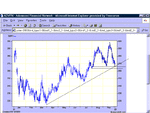Hi all
I must apologise for the delay in getting to this section. I hope it is worth waiting for
🙂
Triangles
Triangles are made up by the interaction of support, resistance and trendlines. The main ones are descending, ascending, symmetrical and expanding:
Descending Triangle
This is the chart of the FTSE index back in Aug 2001
Here, the bottom of the triangle is a horizontal line and the top is made up of the trendline, so in this example the triangle is the interaction of the support line and trendline.
On the chart I’ve labelled points A-G.
A, B, C make up the base
D, E, make up the top
F is the failed attempt to hit the trendline again.
G is the break-out point
Descending Triangles SHOULD break to the downside. The reason is that every time the price bounces off the support line, price doesn’t go up as far as the last time. This is showing that there is more sellers in the market than buyers. The buyers are trying to bring the price up, but after every bounce there is less people wanting to buy so the price doesn’t travel up as far.
If there is less buyers in the market, then the price goes down and the sellers win the battle. Once the support line goes, then the break-out traders come in selling the stock and this causes the price drop.
The best way to explain it is that between points A & D, price rose about 400 points. The next time the support line was tested at point B the price only travelled to point E, only 200 points. The final bounce off C only made it up about 100 points and it didn’t have the buying power to reach and test point F. With the bounces getting smaller and smaller, the only way was down. As a side point, the sell-off started before 9/11 and the FTSE had already lost 200 points before 9/11, so the market was in steep decline.
Ascending Triangle
Ascending Triangles are the same as Descending triangles only upside-down, and they SHOULD break to the upside, as there is more buyers in the market than sellers
Here, the top of the triangle is a horizontal line and the bottom is made up of the trendline, so in this example the triangle is the interaction of the resistance line and trendline.
Symmetric Triangle
A Symmetrical triangle is made up of 2 trendlines that get closer together.
Symmetrical triangles are rare in the market. I’ve taken this from an example on
www.stockcharts.com.
Here the 2 trendlines have come together and the market has broken upwards. Once a trendline breaks then the price will normally carry on in that direction. Which way the price will break from within the triangle is 50:50. As far as I’m aware the likelihood of it breaking up is the same as it breaking down.
Expanding Triangle
An Expanding triangle is made up of 2 trendlines that get further apart. These are harder to trade, because if you base your stop on the break of the trendline against you, each day your risk is increasing
🙁
There are a few other types of triangles, but these are the main ones and the ones that occur the most. The important thing is to draw in the major support, resistance and trendlines, and see how they are interacting with each other. From that you can make a judgement about risk, reward and any potential trade that you see developing.
I haven’t done this for a while, so I thought I would give you these situations to look at. For all of the charts, we’ll be looking at the EOD chart, over the last 6 months.
Those of you with a good eye might be able to spot the triangle in CNA that has already broken
😉
<table border="1" cellpadding="2"> <tr><td>No.</td><td>Ticker</td><td>Name</td><td>Long/Short</td><td>
T2W Online Charting Link</td></tr> <tr><td>1</td><td>BA.</td><td>BAE Systems</td><td>Short</td><td>
BAE Chart</td></tr> <tr><td>2</td><td>BARC</td><td>Barclays </td><td>Short</td><td>
BARC Chart</td></tr> <tr><td>3</td><td>CNA</td><td>Centrica</td><td>Long</td><td>
CNA Chart </td></tr> <tr><td>4</td><td>CW.</td><td>Cable & Wireless</td><td>Long</td><td>
CW. Chart</td></tr> <tr><td>5</td><td>GSK</td><td>GlaxoSmithKline</td><td>Long</td><td>
GSK Chart</td></tr> </table>
You can post charts or just write down your stop-loss, targets and risk / reward. As always there is no right or wrong answers and I would love to hear your views
🙂
My plan for this week is to do a PDF and Word document version of this thread, so those who want to can download it and look at it in their own time
🙂



